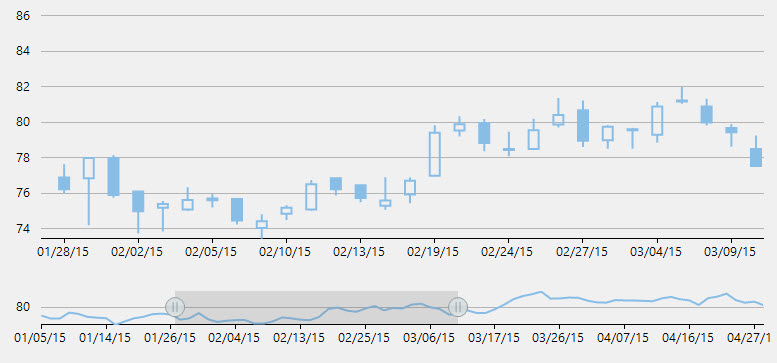Range Selector
FinancialChart's RangeSelector lets a user select a specific range of data to be displayed on the chart. A user can easily bind the RangeSelector with various types of financial charts. It is mostly used by finance industry to perform stock analysis on different data ranges.
The RangeSelector has a left thumb (for minimum value) and right thumb (for maximum value) that lets you scroll through particular time periods on the chart. Users can change the minimum and maximum values of the RangeSelector, and adjust the visible range of data on the chart by dragging these thumbs to left or right. On dragging the thumb towards left on the range bar, you reduce its value, and dragging it towards the right increases its value on the range bar.
To work with RangeSelector, you first need to create a namespace C1.Win.Chart.RangeSelector containing a class RangeSelector in code. Then, to use RangeSelector, you need to create an instance of the RangeSelector class.
The following code snippet illustrates how to use RangeSelector in an application.
Public Class DataService
Public Class DataService
Private _companies As New List(Of Company)()
Public Sub New()
_companies.Add(New Company() With {
.Symbol = "box",
.Name = "Box Inc"
})
_companies.Add(New Company() With {
.Symbol = "fb",
.Name = "Facebook"
})
End Sub
Public Function GetCompanies() As List(Of Company)
Return _companies
End Function
Public Function GetSymbolData(symbol As String) As List(Of Quote)
Dim path As String = String.Format("FinancialChartExplorer.Resources.{0}.json", symbol)
Dim stream = Assembly.GetExecutingAssembly().GetManifestResourceStream(path)
Dim ser = New System.Runtime.Serialization.Json.DataContractJsonSerializer(GetType(Quote()))
Dim data = DirectCast(ser.ReadObject(stream), Quote())
Return data.ToList()
End Function
Shared _ds As DataService
Public Shared Function GetService() As DataService
If _ds Is Nothing Then
_ds = New DataService()
End If
Return _ds
End Function
End Class
Public Class Quote
Public Property [date](/componentone/docs/win/online-financialchart/Interaction/RangeSelector) As String
Get
Return m_date
End Get
Set
m_date = Value
End Set
End Property
Private m_date As String
Public Property high() As Double
Get
Return m_high
End Get
Set
m_high = Value
End Set
End Property
Private m_high As Double
Public Property low() As Double
Get
Return m_low
End Get
Set
m_low = Value
End Set
End Property
Private m_low As Double
Public Property open() As Double
Get
Return m_open
End Get
Set
m_open = Value
End Set
End Property
Private m_open As Double
Public Property close() As Double
Get
Return m_close
End Get
Set
m_close = Value
End Set
End Property
Private m_close As Double
Public Property volume() As Double
Get
Return m_volume
End Get
Set
m_volume = Value
End Set
End Property
Private m_volume As Double
End Class
Public Class Company
Public Property Symbol() As String
Get
Return m_Symbol
End Get
Set
m_Symbol = Value
End Set
End Property
Private m_Symbol As String
Public Property Name() As String
Get
Return m_Name
End Get
Set
m_Name = Value
End Set
End Property
Private m_Name As String
End Class
End Classpublic class DataService
{
List<Company> _companies = new List<Company>();
public DataService()
{
_companies.Add(new Company() { Symbol = "box", Name = "Box Inc" });
_companies.Add(new Company() { Symbol = "fb", Name = "Facebook" });
}
public List<Company> GetCompanies()
{
return _companies;
}
public List<Quote> GetSymbolData(string symbol)
{
string path = string.Format("FinancialChartExplorer.Resources.{0}.json", symbol);
var stream = Assembly.GetExecutingAssembly().GetManifestResourceStream(path);
var ser = new System.Runtime.Serialization.Json.DataContractJsonSerializer(typeof(Quote[]));
var data = (Quote[])ser.ReadObject(stream);
return data.ToList();
}
static DataService _ds;
public static DataService GetService()
{
if (_ds == null)
_ds = new DataService();
return _ds;
}
}
public class Quote
{
public string date { get; set; }
public double high { get; set; }
public double low { get; set; }
public double open { get; set; }
public double close { get; set; }
public double volume { get; set; }
}
public class Company
{
public string Symbol { get; set; }
public string Name { get; set; }
}Partial Public Class RangeSelector
Inherits UserControl
Private rs As C1.Win.Chart.RangeSelector.RangeSelector
Public Sub New()
InitializeComponent()
Dim dataService__1 = DataService.GetService()
Dim data = dataService__1.GetSymbolData("fb")
financialChart1.BeginUpdate()
financialChart1.BindingX = "date"
financialChart1.Binding = "high,low,open,close,volume"
financialChart1.ToolTip.Content = "Date: {date}" & vbLf &
"Open: {open}" & vbLf &
"High: {high}" & vbLf &
"Low: {low}" & vbLf &
"Close: {close}"
financialChart1.Series.Add(New FinancialSeries())
financialChart1.ChartType = C1.Chart.Finance.FinancialChartType.Candlestick
financialChart1.DataSource = data
financialChart1.EndUpdate()
financialChart2.BeginUpdate()
financialChart2.BindingX = "date"
financialChart2.Binding = "close"
financialChart2.Series.Add(New FinancialSeries())
financialChart2.ChartType = C1.Chart.Finance.FinancialChartType.Line
financialChart2.DataSource = data
financialChart2.ToolTip.Content = Nothing
financialChart2.EndUpdate()
End Sub
Private Sub RangeSelector_Load(sender As Object, e As EventArgs)
AddHandler financialChart2.Rendered, AddressOf financialChart2_Rendered
End Sub
Private Sub financialChart2_Rendered(sender As Object, e As C1.Win.Chart.RenderEventArgs)
If rs Is Nothing AndAlso financialChart2.AxisX.ActualMin <> financialChart2.AxisX.ActualMax Then
rs = New C1.Win.Chart.RangeSelector.RangeSelector(financialChart2)
AddHandler rs.ValueChanged, AddressOf rs_ValueChanged
End If
End Sub
Private Sub rs_ValueChanged(sender As Object, e As EventArgs)
financialChart1.AxisX.Min = rs.LowerValue
financialChart1.AxisX.Max = rs.UpperValue
End Sub
End Classpublic partial class RangeSelector : UserControl
{
C1.Win.Chart.RangeSelector.RangeSelector rs;
public RangeSelector()
{
InitializeComponent();
var dataService = DataService.GetService();
var data = dataService.GetSymbolData("fb");
financialChart1.BeginUpdate();
financialChart1.BindingX = "date";
financialChart1.Binding = "high,low,open,close,volume";
financialChart1.ToolTip.Content = "Date: {date}\nOpen: {open}\nHigh: {high}\nLow: {low}\nClose: {close}";
financialChart1.Series.Add(new FinancialSeries());
financialChart1.ChartType = C1.Chart.Finance.FinancialChartType.Candlestick;
financialChart1.DataSource = data;
financialChart1.EndUpdate();
financialChart2.BeginUpdate();
financialChart2.BindingX = "date";
financialChart2.Binding = "close";
financialChart2.Series.Add(new FinancialSeries());
financialChart2.ChartType = C1.Chart.Finance.FinancialChartType.Line;
financialChart2.DataSource = data;
financialChart2.ToolTip.Content = null;
financialChart2.EndUpdate();
}
private void RangeSelector_Load(object sender, EventArgs e)
{
financialChart2.Rendered += financialChart2_Rendered;
}
void financialChart2_Rendered(object sender, C1.Win.Chart.RenderEventArgs e)
{
if (rs == null && financialChart2.AxisX.ActualMin != financialChart2.AxisX.ActualMax)
{
rs = new C1.Win.Chart.RangeSelector.RangeSelector(financialChart2);
rs.ValueChanged += rs_ValueChanged;
}
}
void rs_ValueChanged(object sender, EventArgs e)
{
financialChart1.AxisX.Min = rs.LowerValue;
financialChart1.AxisX.Max = rs.UpperValue;
}
}


